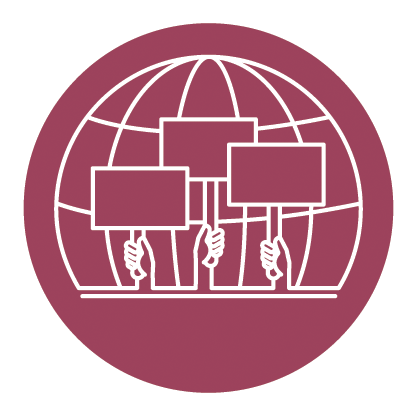Types of Civic Engagement
At Illinois State University, civic engagement involves developing the combination of knowledge, skills, values, and motivation to make a difference in the civic life of our communities and promoting the quality of life in a community through both political and non-political processes. As you can imagine, the act of civic engagement can be conducted in many ways. To help clarify the various types of engagement typically conducted at Illinois State, projects were analyzed and put into nine different classifications to help better understand the various was faculty, staff, and students are engaging with civic issues and community organizations. Please see the bottom of the page for definitions of community engagement and community-engaged teaching, scholarship, and service.

Below are descriptions of the various ways Illinois State practices civic engagement and some examples from actual projects. Please note that the classifications listed below are not mutually exclusive.
-

Activism/Advocacy: Involves organizing to bring about political or social change or to show support for, bring awareness to, or promote a particular cause or policy.
- Example: BSC 365: Bioenergy Plant/Microbe Biology and the Environment. Students took some form of action that addressed/brought awareness to an issue or issues related to climate change and/or bioenergy).
- Example: FLAME hosts a Take Back The Night rally on the quad.
- Example: Illinois State Theatre Outreach Program (ISTOP) student organization puts on theatrical productions that address/raise awareness on important social issues that affect communities.
-

Civic Learning: Acquiring knowledge of community, government, social issues, or political issues with or without the application of the knowledge.
- Example: PHI 104: The Ideal of Democracy. Students attended a Town Council meeting and wrote a paper about their experience.
- Example: THE 314: Acting Styles Discovery & Performance: On Camera. Students created short videos to contribute to the public good emphasizing issues of public concern or highlighting a local organization.
-

Community Service/Volunteerism: Engaging in activities to benefit others or one's community; such activities may or may not involve structured training and reflection.
- Example: SPA 214: Oral Communication in Spanish. Students were required to seek out of class opportunities to speak Spanish. These opportunities could include doing so in a volunteer setting.
- Example: A fraternity volunteers on a Saturday afternoon at Habitat ReStore.
-

Service Learning: Involves intentionally linking service activities with student learning objectives to mutually benefit the recipient (community organization) and the provider (student) by addressing real community needs while students apply what they have learned and advance that learning through active engagement and reflection.
- Example: ACC 261: Business Systems Analysis. Students performed business needs analysis to identify a problem, create data flow diagrams to understand processes, and to recommend process changes and technical solutions to mitigate problems for a community organization
- Example: CTK 330: Web Video & CTK 480: Advanced Computer Topics in Arts Technology. The classes partnered with Luther Oaks Retirement Community's Memory Care Unit to create a series of interactive, musical quilts that connect to songs from the resident's youth.
- Example: Student participating in an Alternative Spring Break trip clean up the Mississippi river. Throughout the trip they learn about the community partners’ efforts and long term goals. At night students participate in reflective conversation and explore root causes.
-

Community Engaged Internship:Provides students with hands-on experiences that enhance their learning or understanding of social or political issues relevant to a particular area of study. Course is denoted as “Professional Practice” in the university catalog.
- Example: ART 398A02: Professional Practice - Internship in Design. Graphic design students served as interns for community organizations
- Example: A student interning with Caterpillar benchmarks and reports on sustainability practices.
-

Philanthropy/Fundraising:Collection of resources (e.g., money, food, clothing, etc.) to benefit charitable organizations or agencies.
- Example: COM 110: Communication as Critical Inquiry. Students raised $1,200 to support the educational expenses of a child in the Congo, allowing the child to go to school instead of working in the mines.
- Example: Criminal Justice Sciences RSO hosted a clothing drive for Sheridan Prison to provide clothes to inmates as they are released and for job interviews.
-

Political Engagement:Developing one’s own political understandings and views that may be expressed by challenging political ideas of others and/or influencing policies or political positions.
- Example: School of Kinesiology and Recreation. Students participated in SHAPE UP Illinois where they spoke with Illinois legislators in person about the importance of K-12 physical education curriculum in schools.
- Example: Various courses where students research political topics and debate in class.
-

Community Engaged Research:Creation of new knowledge in collaboration with or on behalf of a community partner that contributes to student learning within the academic discipline while also strengthening the well-being of the community by working to solve or understand an issue of public concern.
- Example: PSY 290: Research Apprenticeship. Psychology students conducted applied research and behavioral consulting for Pet Central Helps Animal Rescue and Shelter. Students worked with individual clients, prepared and implemented behavior change plans for the dogs, and worked with the director and board to develop and research factors in foster parent retention and best-practice training programs.
- Example: FCS 319: Quantity Foods students identified common food/nutrition problems, created research based infographics and displayed them in schools, hospitals, or dining centers. Research was for the specific location in which the infographic would be displayed.
-

Social Entrepreneurship/Social Innovation:Combining innovation, resourcefulness, and opportunity to address critical social and environmental challenges through the development of business models, products, or services.
- Example: A student created Drake’s Toys subscription box company for children with special needs and received funding through the Means Center for Entrepreneurial Studies Startup Showcase.
- Example: Fix It Friday. Fashion Design and Merchandising Association students provide free clothing repairs on campus, in Bloomington-Normal, and in Chicago to reduce textiles in landfills and allow for development of textile economies in underdeveloped countries.
Civic Engagement Continuum
The various types of civic engagement described above all fall within a continuum in terms of their intended beneficiary and intended focus. View the continuum.

Definition of Community Engagement
Community engagement is form of civic engagement that cultivates partnerships between the institution and communities to co-create knowledge and positive change through mutually beneficial reciprocal relationships. It can be present in teaching, research/creative activity, and service; meaningful community engagement benefits the community and prepares students to be ethical, informed, and engaged community members, who recognize the assets of communities, while working for positive change.
Definitions of Community-Engaged Teaching, Scholarship, and Service
Community-engaged teaching is instruction that gives students the chance to collaborate with community partners to define and address community goals and to engage in structured reflection designed to help students achieve civic engagement learning outcomes (adapted from The Carnegie Foundation for the Advancement of Teaching; Jacoby, 1996, 2014).
Community-engaged scholarship is scholarship that involves the faculty member in a mutually beneficial partnership with the community and can be found in teaching, research and/or service. It is academically relevant work that simultaneously addresses disciplinary concerns and fulfills campus and community objectives, and results in scholarship deriving from teaching, discovery, integration, application, or engagement. It involves sharing authority with community partners in the development of goals and approaches, as well the conduct of work and its dissemination. It should involve critical review by discipline-specific peers, community partners and the public (Engaged Scholarship Advisory Committee, 2012; Jordan, 2007).
Community-engaged service involves activities that “1) affirm principles of community engagement (mutually beneficial partnerships, public purpose), and 2) ―enable the University to carry out its mission, contribute to the function and effectiveness of the faculty member‘s profession and discipline, and reach out to external communities and constituencies, such as government agencies, business, and the arts” (Janke & Shelton, 2011, p. 8).